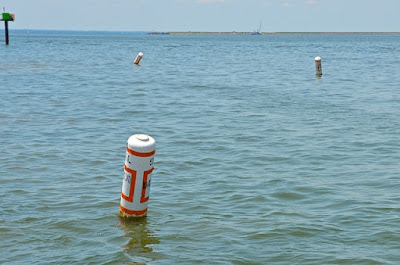
While washing the siphon coffee maker in the saloon (way too much work but it does make great coffee), I looked out the starboard windows and saw the resident mallards preening their feathers. I had observed their none to delicate courting behavior and their other antics the day before. They took a cocktail break in the late afternoon. A little more quacking and swimming followed, and then they gathered under the trees just south of the marina’s office.
They were still there in the early morning nestled in the grass or on one leg with their beaks tucked under their feathers. One eye eyed me as I passed, they are still wild animals after all but they did not stir, obviously use to bleary-eyed sailors in various states of disrepair walking by.
I started to think that being a duck might not be a bad idea and then remembered the multitude of duck blinds and duck decoy museums Carrie Rose has cruised by on rivers from Canada to here in the Chesapeake. Maybe, since I have the choice, I should aspire to something other than waterfowl, something more majestic.
On our time on the water watching birds has been a major attraction: eagles, osprey, herons, kingfishers, robins and warblers and sparrows and doves and gulls and terns. Now there is a bird, the tern. They are sleek in the way a 57 Chevy is. In terms of flying, they fly the pants off your average gull. Too see them soar, hover, then dive head long into the water, and come out with a twitching bit of silver between their beak is a marvel.
One thing I cannot say much for is their squawk. Grating is an appropriate description. The Peterson’s Field Guide to Birds describes it in varying ways depending on the type. From the Forster’s tern’s harsh, nasal kyarr to the rasping ka-a-ak of the Roseate tern, and “A harsh, squealing zree-k-zeek” of the diminutive Least tern.
And speaking of the Least tern aka Sternula antillarum, it is my pick, at least for today. A small tern, only nine inches from the tip of its pointed beak to the tips of its forked tail. When I first saw one on a dingy cruise up and down the La Trappe Creek in Maryland I thought it was a Purple Martin until I saw it hover and dive. It landed on a buoy and proceeded to enjoy its catch. Then I noticed several of its compatriots inhabiting a near by pier. They looked like a jolly self contained group.
Though the above reference mentions that they are “Threatened by disturbance and habitat loss” it appears, they live along the coast of North America from Maine to Texas, along the southern Mississippi, and in a few western river basins. Central America, the Caribbean, and northern South America are their wintering sites. I’d prefer Southern South America but then you can’t have everything.
So, for today, June 30, 2016, I will be reincarnated as a Least tern. When I get back to civilization, I will contact the lawyer to add an addendum to the trust to reflect my wishes. Now back to washing the coffee maker…



















